Berg J.M., Tymoczko J.L., Stryer L. Biochemistry
Подождите немного. Документ загружается.


II. Transducing and Storing Energy 23. Protein Turnover and Amino Acid Catabolism 23.2. Protein Turnover Is Tightly Regulated
Figure 23.6. 26S Proteasome. A 19S cap is attached to each end of the 20S catalytic unit. [From W. Baumeister, J.
Walz, F. Zuhl, and E. Seemuller. Cell 92(1998):367. Courtesy of Dr. Wolfgang Baumeister.]
II. Transducing and Storing Energy 23. Protein Turnover and Amino Acid Catabolism 23.2. Protein Turnover Is Tightly Regulated
Table 23.2. Processes regulated by protein degradation
Gene transcription
Cell-cycle progression
Organ formation
Circadian rhythms
Inflammatory response
Tumor suppression
Cholesterol metabolism
Antigen processing
II. Transducing and Storing Energy 23. Protein Turnover and Amino Acid Catabolism 23.2. Protein Turnover Is Tightly Regulated

Figure 23.7. Proteasome Evolution. The archaeal proteasome consists of 14 identical α subunits and 14 identical β
subunits. In the eukaryotic proteasome, gene duplication and specialization has led to 7 distinct subunits of each type.
The overall architecture of the proteasome is conserved.
II. Transducing and Storing Energy 23. Protein Turnover and Amino Acid Catabolism 23.2. Protein Turnover Is Tightly Regulated
Figure 23.8. Biosynthesis of Thiamine. The biosynthesis of thiamine begins with the addition of sulfide to the carboxyl
terminus of the protein ThiS. This protein is activated by adenylation and conjugated in a manner analogous to the first
steps in the ubiquitin pathway.
II. Transducing and Storing Energy 23. Protein Turnover and Amino Acid Catabolism 23.2. Protein Turnover Is Tightly Regulated
Figure 23.9. Structure of This.
The determination of the structure of ThiS revealed it to be structurally similar to
ubiquitin despite only 14% sequence identity. This observation suggests that a prokaryotic protein such as ThiS
evolved into ubiquitin.
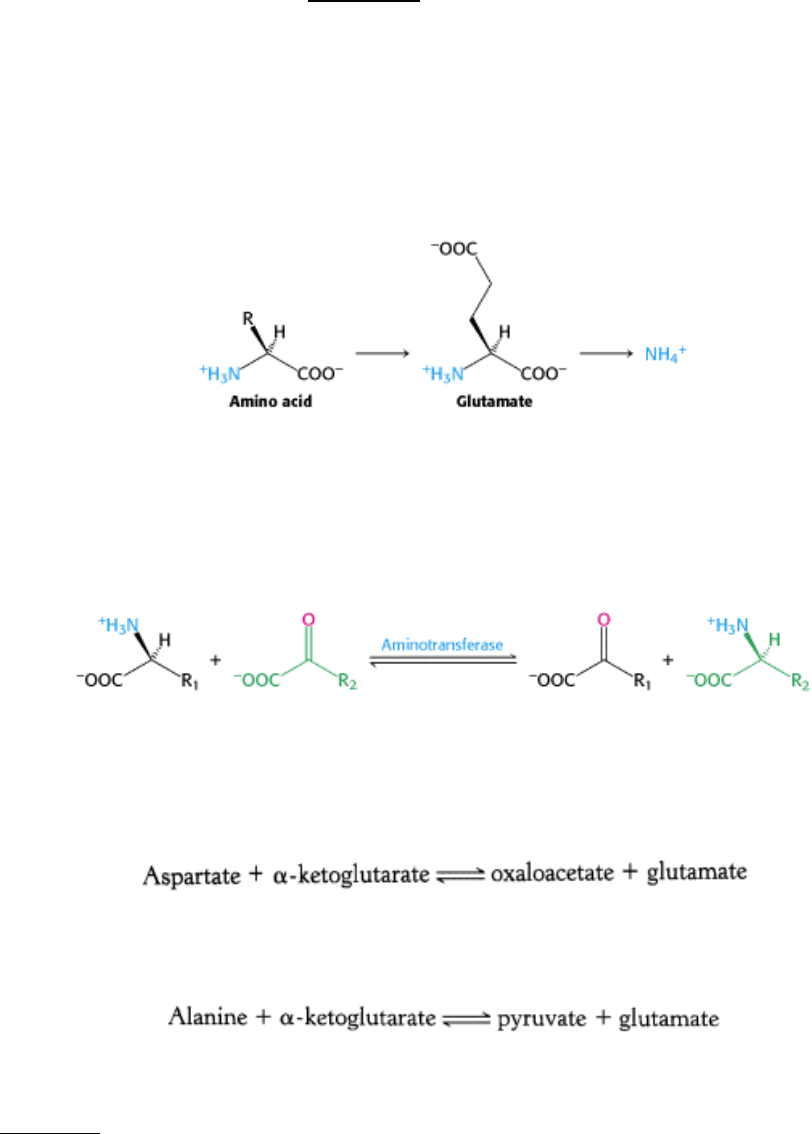
II. Transducing and Storing Energy 23. Protein Turnover and Amino Acid Catabolism
23.3. The First Step in Amino Acid Degradation Is the Removal of Nitrogen
What is the fate of amino acids released on protein digestion or turnover? Any not needed as building blocks are
degraded to specific compounds. The major site of amino acid degradation in mammals is the liver. The amino group
must be removed, inasmuch as there are no nitrogenous compounds in energy-transduction pathways. The α-ketoacids
that result from the deamination of amino acids are metabolized so that the carbon skeletons can enter the metabolic
mainstream as precursors to glucose or citric acid cycle intermediates. The fate of the α-amino group will be considered
first, followed by that of the carbon skeleton (Section 23.5).
23.3.1. Alpha-Amino Groups Are Converted into Ammonium Ions by the Oxidative
Deamination of Glutamate
The α-amino group of many amino acids is transferred to α-ketoglutarate to form glutamate, which is then oxidatively
deaminated to yield ammonium ion (NH
4
+
).
Aminotransferases catalyze the transfer of an α-amino group from an α-amino acid to an α-ketoacid. These enzymes,
also called transaminases, generally funnel α-amino groups from a variety of amino acids to α-keto-glutarate for
conversion into NH
4
+
.
Aspartate aminotransferase, one of the most important of these enzymes, catalyzes the transfer of the amino group of
aspartate to α-ketoglutarate.
Alanine aminotransferase catalyzes the transfer of the amino group of alanine to α-ketoglutarate.
These transamination reactions are reversible and can thus be used to synthesize amino acids from α-ketoacids, as we
shall see in Chapter 24.
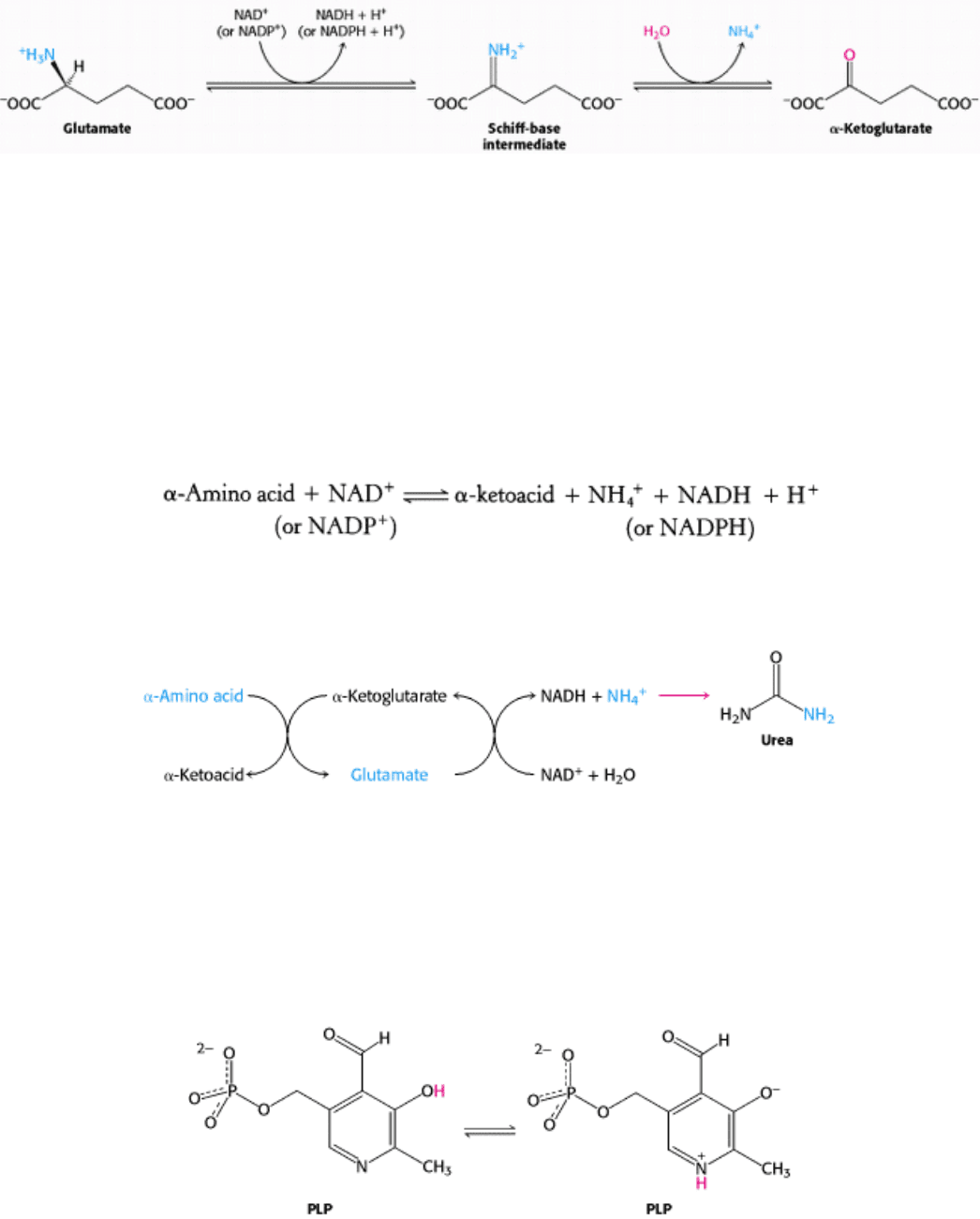
The nitrogen atom that is transferred to α-ketoglutarate in the transamination reaction is converted into free ammonium
ion by oxidative deamination. This reaction is catalyzed by glutamate dehydrogenase. This enzyme is unusual in being
able to utilize either NAD
+
or NADP
+
, at least in some species. The reaction proceeds by dehydrogenation of the C-N
bond, followed by hydrolysis of the resulting Schiff base.
The equilibrium for this reaction favors glutamate; the reaction is driven by the consumption of ammonia. Glutamate
dehydrogenase is located in mitochondria, as are some of the other enzymes required for the production of urea. This
compartmentalization sequesters free ammonia, which is toxic.
In vertebrates, the activity of glutamate dehydrogenase is allosterically regulated. The enzyme consists of six identical
subunits. Guanosine triphosphate and adenosine triphosphate are allosteric inhibitors, whereas guanosine diphosphate
and adenosine diphosphate are allosteric activators. Hence, a lowering of the energy charge accelerates the oxidation of
amino acids.
The sum of the reactions catalyzed by aminotransferases and glutamate dehydrogenase is
In most terrestrial vertebrates, NH
4
+
is converted into urea, which is excreted.
23.3.2. Pyridoxal Phosphate Forms Schiff-Base Intermediates in Aminotransferases
All aminotransferases contain the prosthetic group pyridoxal phosphate (PLP), which is derived from pyridoxine
(vitamin B
6
). Pyridoxal phosphate includes a pyridine ring that is slightly basic as well as a phenolic hydroxyl group
that is slightly acidic. Thus, pyridoxal phosphate derivatives can form stable tautomeric forms in which the pyridine
nitrogen atom is protonated and, hence, positively charged while the hydroxyl group is deprotonated, forming a
phenolate.
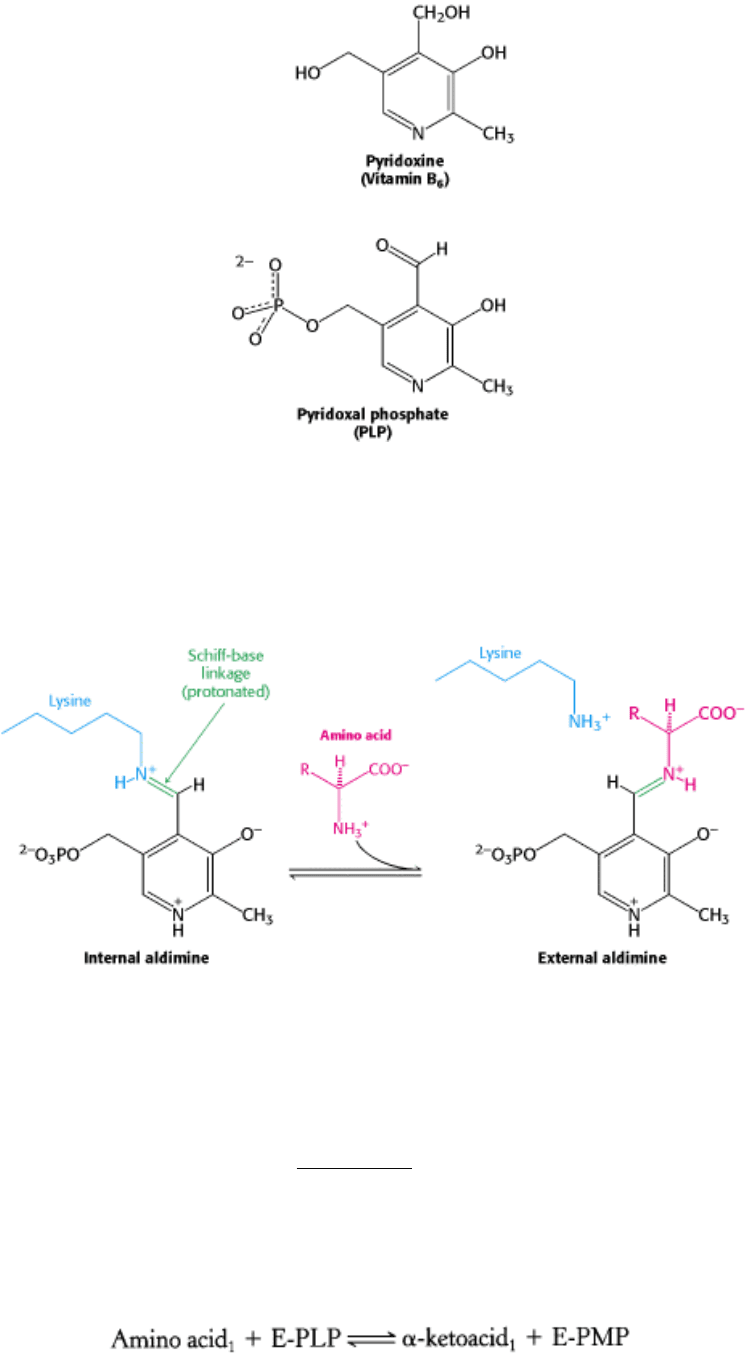
The most important functional group on PLP is the aldehyde. This group allows PLP to form covalent Schiff-base
intermediates with amino acid substrates. Indeed, even in the absence of substrate, the aldehyde group of PLP usually
forms a Schiff-base linkage with the ε-amino group of a specific lysine residue of the enzyme. A new Schiff-base
linkage is formed on addition of an amino acid substrate. These Schiff-base linkages are often protonated, with the
positive charge stabilized by interaction with the negatively charged phenolate group of PLP.
The α -amino group of the amino acid substrate displaces the ε-amino group of the active-site lysine residue. In other
words, an internal aldimine becomes an external aldimine. The amino acid-PLP Schiff base that is formed remains
tightly bound to the enzyme by multiple noncovalent interactions.
The Schiff base between the amino acid substrate and PLP, the external aldimine, loses a proton from the α-carbon atom
of the amino acid to form a quinonoid intermediate (Figure 23.10).
The negative charge that is left on the amino acid is stabilized by delocalization into the pyridinium ring. Reprotonation
of this intermediate at the aldehyde carbon atom yields a ketimine. The ketimine is then hydrolyzed to an α-ketoacid and
pyridoxamine phosphate (PMP). These steps constitute half of the transamination reaction.
The second half takes place by the reverse of the preceding pathway. A second α-ketoacid reacts with the enzyme-
pyridoxamine phosphate complex (E-PMP) to yield a second amino acid and regenerate the enzyme-pyridoxal phosphate
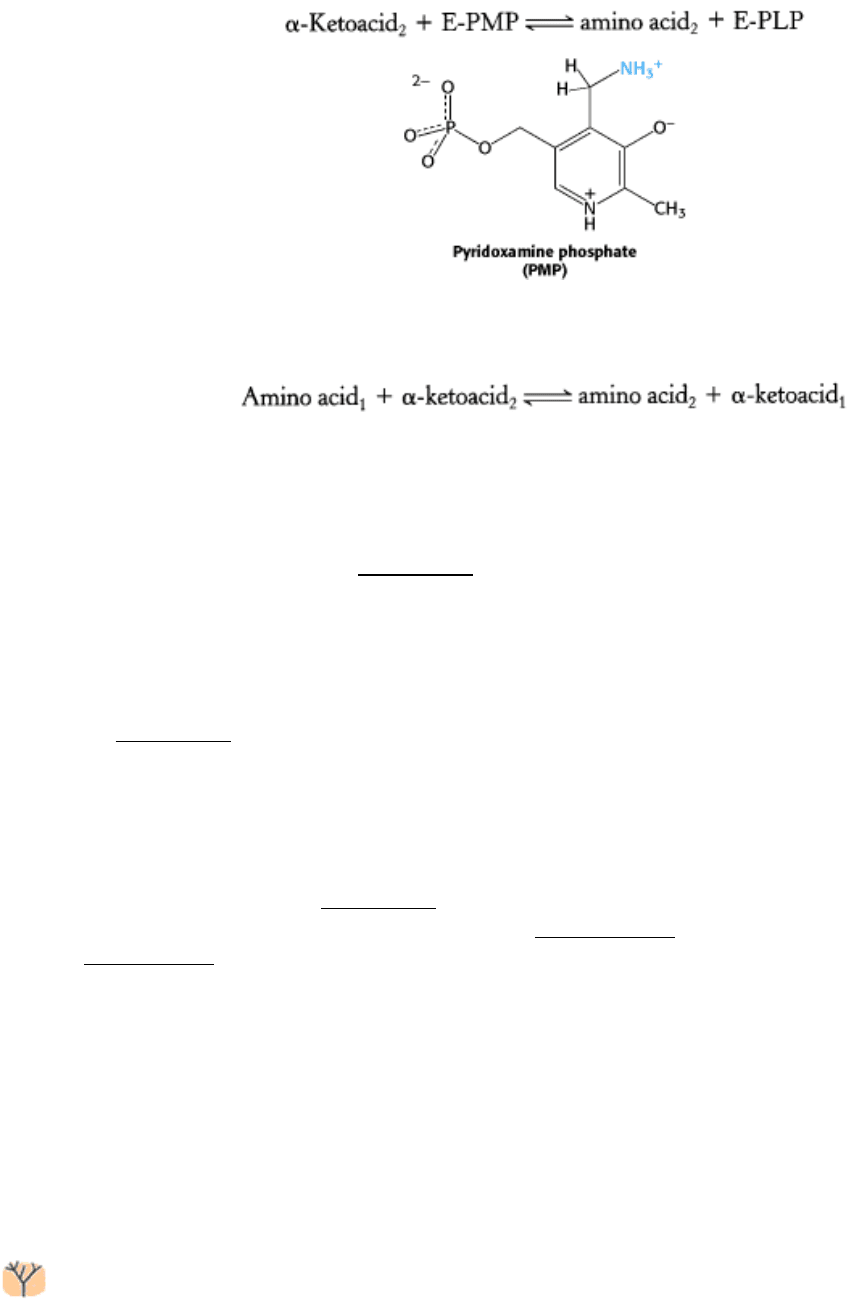
complex (E-PLP).
The sum of these partial reactions is
23.3.3. Aspartate Aminotransferase Is a Member of a Large and Versatile Family of
Pyridoxal-Dependent Enzymes
The mitochondrial enzyme aspartate aminotransferase provides an especially well studied example of PLP as a
coenzyme for transamination reactions (Figure 23.11). The results of X-ray crystallographic studies provided detailed
views of how PLP and substrates are bound and confirmed much of the proposed catalytic mechanism. Each of the
identical 45-kd subunits of this dimer consists of a large domain and a small one. PLP is bound to the large domain, in a
pocket near the subunit interface. In the absence of substrate, the aldehyde group of PLP is in a Schiff-base linkage with
lysine 258, as anticipated. Adjacent to the coenzyme's binding site is a conserved arginine residue that interacts with the
α-carboxylate group of the substrate, helping to orient the substrate appropriately in the active site. The transamination
reaction (see Figure 23.10) requires a base to remove a proton from the α-carbon group of the amino acid and to transfer
it to the aldehyde carbon atom of PLP. The lysine amino group that was initially in Schiff-base linkage with PLP appears
to serve this role.
Transamination is just one of a wide range of amino acid transformations that are catalyzed by PLP enzymes. The other
reactions catalyzed by PLP enzymes at the α-carbon atom of amino acids are decarboxylations, deam-inations,
racemizations, and aldol cleavages (Figure 23.12). In addition, PLP enzymes catalyze elimination and replacement
reactions at the β-carbon atom (e.g., tryptophan synthetase; Section 24.2.11) and the γ-carbon atom (e.g., cytathionine β-
synthase, Section 24.2.9) of amino acid substrates. Three common features of PLP catalysis underlie these diverse
reactions.
1. A Schiff base is formed by the amino acid substrate (the amine component) and PLP (the carbonyl component).
2. The protonated form of PLP acts as an electron sink to stabilize catalytic intermediates that are negatively charged.
Electrons from these intermediates can be transferred into the pyridine ring to neutralize the positive charge on the
pyridinium nitrogen. In other words, PLP is an electrophilic catalyst.
3. The product Schiff base is cleaved at the completion of the reaction.
Many of the enzymes that catalyze these reactions, such as serine hy- droxymethyltransferase, which converts
serine into glycine, have the same fold as that of aspartate aminotransferase and are clearly related by divergent
evolution. Others, such as tryptophan synthetase, have quite different overall structures. Nonetheless, the active sites of
these enzymes are remarkably similar to that of aspartate aminotransferase, revealing the effects of convergent evolution.

How does a particular enzyme selectively favor the cleavage of one of three bonds at the α-carbon atom of an amino
acid substrate? An important principle is that the bond being broken must be perpendicular to the π orbitals of the
electron sink (Figure 23.13). An aminotransferase, for example, achieves this goal by binding the amino acid substrate so
that the C
α
-H bond is perpendicular to the PLP ring (Figure 23.14). In serine hydroxymethyltransferase, the N-C
α
bond
is rotated so that the C
α
-C
β
bond is most nearly perpendicular to the plane of the PLP ring, favoring its cleavage. This
means of choosing one of several possible catalytic outcomes is called stereoelectronic control.
23.3.4. Serine and Threonine Can Be Directly Deaminated
Although the nitrogen atoms of most amino acids are transferred to α-ketoglutarate before removal, the α-amino groups
of serine and threonine can be directly converted into NH
4
+
. These direct deaminations are catalyzed by serine
dehydratase and threonine dehydratase, in which PLP is the prosthetic group.
These enzymes are called dehydratases because dehydration precedes deamination. Serine loses a hydrogen ion from its
α-carbon atom and a hydroxide ion group from its β-carbon atom to yield aminoacrylate. This unstable compound reacts
with H
2
O to give pyruvate and NH
4
+
. Thus, the presence of a hydroxyl group attached to the β-carbon atom in each of
these amino acids permits the direct deamination.
23.3.5. Peripheral Tissues Transport Nitrogen to the Liver
Most amino acid degradation takes place in tissues other than the liver. For instance, muscle uses amino acids as a source
of fuel during prolonged exercise and fasting. How is the nitrogen processed in these other tissues? As in the liver, the
first step is the removal of the nitrogen from the amino acid. However, muscle lacks the enzymes of the urea cycle, so
the nitrogen must be released in a form that can be absorbed by the liver and converted into urea.
Nitrogen is transported from muscle to the liver in two principal transport forms. Glutamate is formed by transamination
reactions, but the nitrogen is then transferred to pyruvate to form alanine, which is released into the blood (Figure 23.15).
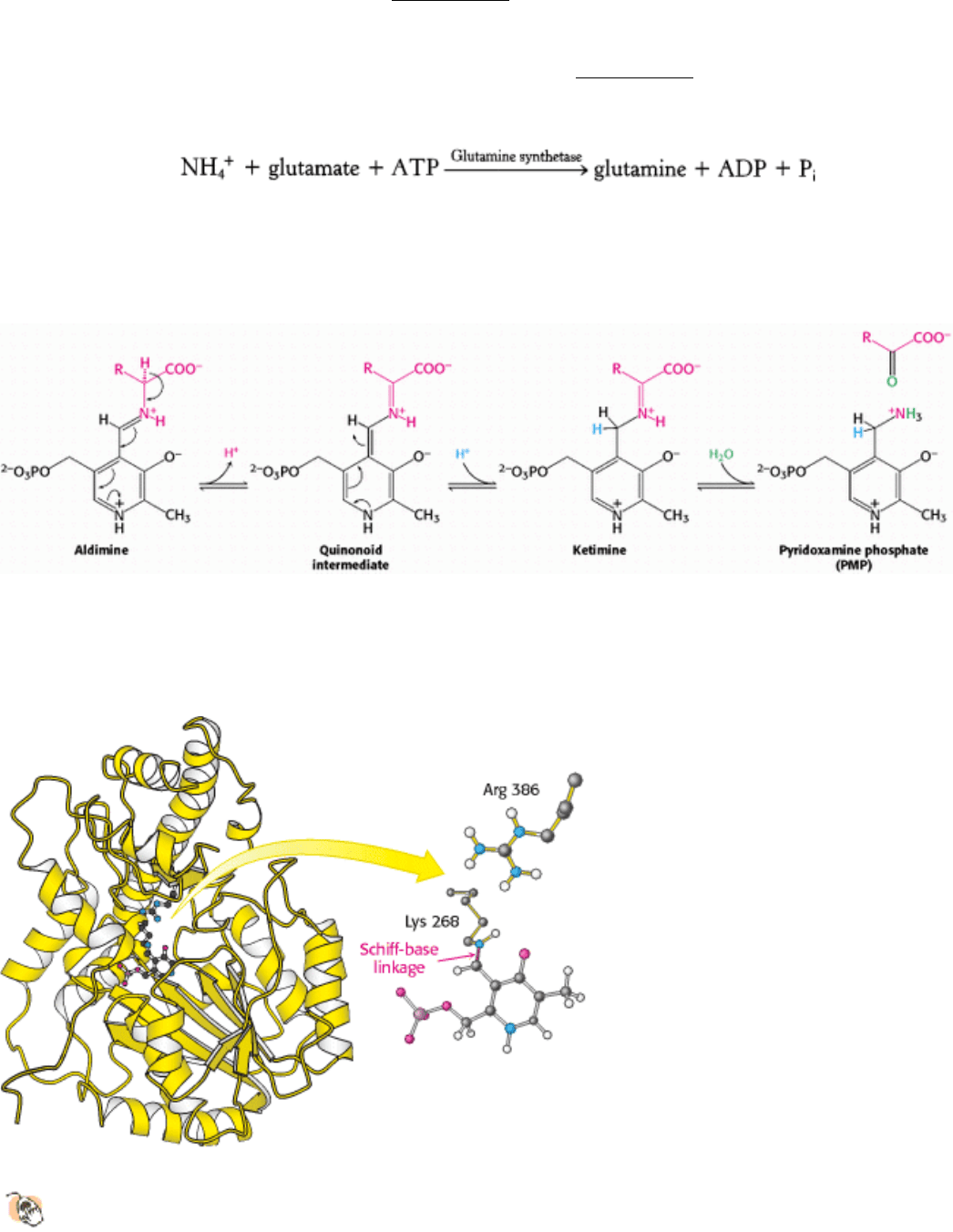
The liver takes up the alanine and converts it back into pyruvate by transamination. The pyruvate can be used for
gluconeogenesis and the amino group eventually appears as urea. This transport is referred to as the alanine cycle. It is
reminiscent of the Cori cycle discussed earlier (Section 16.4.2) and again illustrates the ability of the muscle to shift
some of its metabolic burden to the liver.
Nitrogen can also be transported as glutamine. Glutamine synthetase (Section 24.1.2) catalyzes the synthesis of
glutamine from glutamate and NH
4
+
in an ATP-dependent reaction:
The nitrogens of glutamine can be converted into urea in the liver.
II. Transducing and Storing Energy 23. Protein Turnover and Amino Acid Catabolism 23.3. The First Step in Amino Acid Degradation Is the Removal of Nitrogen
Figure 23.10. Transamination Mechanism. The external aldimine loses a proton to form a quinonoid intermediate.
Reprotonation of this intermediate at the aldehyde carbon atom yields a ketimine. This intermediate is hydrolyzed to
generate the α-ketoacid product and pyridoxamine phosphate.
II. Transducing and Storing Energy 23. Protein Turnover and Amino Acid Catabolism 23.3. The First Step in Amino Acid Degradation Is the Removal of Nitrogen
Figure 23.11. Aspartate Aminotransferase.
The active site of this prototypical PLP-dependent enzyme includes
pyridoxal phosphate attached to the enzyme by a Schiff-base linkage with lysine 258. An arginine residue in the
active site helps orient substrates by binding to their α-carboxylate groups.

II. Transducing and Storing Energy 23. Protein Turnover and Amino Acid Catabolism 23.3. The First Step in Amino Acid Degradation Is the Removal of Nitrogen
Figure 23.12. Bond Cleavage by PLP Enzymes. Pyridoxal phosphate enzymes labilize one of three bonds at the α-
carbon atom of an amino acid substrate. For example, bond a is labilized by aminotransferases, bond b by
decarboxylases, and bond c by aldolases (such as threonine aldolases). PLP enzymes also catalyze reactions at the β- and
γ-carbon atoms of amino acids.
II. Transducing and Storing Energy 23. Protein Turnover and Amino Acid Catabolism 23.3. The First Step in Amino Acid Degradation Is the Removal of Nitrogen
Figure 23.13. Stereoelectronic Effects. The orientation about the NH-Cα bond determines the most favored reaction
catalyzed by a pyridoxal phosphate enzyme. The bond that is most nearly perpendicular to the π orbitals of the pyridoxal
phosphate electron sink is most easily cleaved.
II. Transducing and Storing Energy 23. Protein Turnover and Amino Acid Catabolism 23.3. The First Step in Amino Acid Degradation Is the Removal of Nitrogen
Figure 23.14. Reaction Choice. In aspartate aminotransferase, the Cα-H bond is most nearly perpendicular to the π-
orbital system and is cleaved. In serine hydroxymethyltransferase, a small rotation about the N-Cα bond places the Cα-
Cβ bond perpendicular to the π system, favoring its cleavage.

II. Transducing and Storing Energy 23. Protein Turnover and Amino Acid Catabolism 23.3. The First Step in Amino Acid Degradation Is the Removal of Nitrogen
Figure 23.15. The Alanine Cycle. Glutamate in muscle is transaminated to alanine, which is released into the
bloodstream. In the liver, alanine is taken up and converted into pyruvate for subsequent metabolism.
II. Transducing and Storing Energy 23. Protein Turnover and Amino Acid Catabolism
23.4. Ammonium Ion Is Converted Into Urea in Most Terrestrial Vertebrates
Some of the NH
4
+
formed in the breakdown of amino acids is consumed in the biosynthesis of nitrogen compounds. In
most terrestrial vertebrates, the excess NH
4
+
is converted into urea and then excreted. Such organisms are referred to as
ureotelic.
In terrestrial vertebrates, urea is synthesized by the urea cycle (Figure 23.16). The urea cycle, proposed by Hans Krebs
and Kurt Henseleit in 1932, was the first cyclic metabolic pathway to be discovered. One of the nitrogen atoms of the
urea is transferred from an amino acid, aspartate. The other nitrogen atom is derived directly from free NH
4
+
, and the
carbon atom comes from HCO
3
-
(derived by hydration of CO
2
; see Section 9.2).
23.4.1. The Urea Cycle Begins with the Formation of Carbamoyl Phosphate
The urea cycle begins with the coupling of free NH
4
+
with HCO
3
-
to form carbamoyl phosphate. The synthesis of
carbamoyl phosphate, though a simple molecule, is complex, comprising three steps, all catalyzed by carbamoyl
phosphate synthetase.
